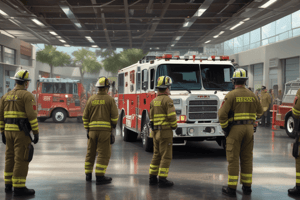Podcast
Questions and Answers
What can a S95 holder do?
What can a S95 holder do?
- Reset fire alarm systems
- Replace faulty detectors
- Conduct full inspections of fire alarm systems
- Only visual inspections on smoke alarms (correct)
What is the primary purpose of fire alarm systems on a premise?
What is the primary purpose of fire alarm systems on a premise?
To warn tenants and transmit signals indicating a fire condition to the FDNY.
What does FACP stand for?
What does FACP stand for?
Fire Alarm Control Panel.
What are the three types of fire alarm signals?
What are the three types of fire alarm signals?
What is a fire alarm signal?
What is a fire alarm signal?
What do supervisory signals indicate?
What do supervisory signals indicate?
What are trouble signals?
What are trouble signals?
What is the function of the alarm silence switch?
What is the function of the alarm silence switch?
How often must smoke detectors be cleaned?
How often must smoke detectors be cleaned?
What should primary power for fire alarm systems not exceed?
What should primary power for fire alarm systems not exceed?
What must be reported promptly when a fire alarm system is out-of-service?
What must be reported promptly when a fire alarm system is out-of-service?
What types of fires does Class A involve?
What types of fires does Class A involve?
Portable fire extinguishers are required to be checked _____.
Portable fire extinguishers are required to be checked _____.
Which of the following describes a carbon monoxide detector in alarm condition?
Which of the following describes a carbon monoxide detector in alarm condition?
What is the proper method to return fixed-temperature heat detectors to service?
What is the proper method to return fixed-temperature heat detectors to service?
What is a beam detector used for?
What is a beam detector used for?
Flashcards
S-95 Certificate
S-95 Certificate
Authorization for visual inspections of smoke alarms only.
Fire Alarm Control Panel (FACP)
Fire Alarm Control Panel (FACP)
Device monitoring inputs and controlling outputs during fire alerts.
Fire Alarm Signals
Fire Alarm Signals
Signals initiated during a fire by manual stations or detectors.
Supervisory Signals
Supervisory Signals
Signup and view all the flashcards
Trouble Signals
Trouble Signals
Signup and view all the flashcards
Alarm Silence Switch
Alarm Silence Switch
Signup and view all the flashcards
System Reset Switch
System Reset Switch
Signup and view all the flashcards
Smoke Detectors
Smoke Detectors
Signup and view all the flashcards
Fixed-temperature Detectors
Fixed-temperature Detectors
Signup and view all the flashcards
Rate-of-rise Detectors
Rate-of-rise Detectors
Signup and view all the flashcards
Ionization Detectors
Ionization Detectors
Signup and view all the flashcards
Photoelectric Detectors
Photoelectric Detectors
Signup and view all the flashcards
Class A Fires
Class A Fires
Signup and view all the flashcards
Class B Fires
Class B Fires
Signup and view all the flashcards
Monthly Extinguisher Checks
Monthly Extinguisher Checks
Signup and view all the flashcards
Alarm Logs Documentation
Alarm Logs Documentation
Signup and view all the flashcards
Study Notes
S-95 FDNY Test Overview
- S-95 certificate holders are authorized to perform visual inspections on smoke alarms only.
- Fire alarm systems primarily function to alert tenants and signal the FDNY via a central station about fire incidents.
Fire Alarm Control System
- Fire Alarm Control Panel (FACP) is crucial for monitoring inputs and controlling outputs through various circuits, activating audible and visual alarms.
Signal Types
- There are three main signal types:
- Fire Alarm Signals: Initiated by manual pull stations, smoke detectors, or water flow switches during a fire.
- Supervisory Signals: Indicate abnormal conditions of monitored systems requiring attention.
- Trouble Signals: Highlight failures like battery or AC issues, or circuit malfunctions.
Alarm Management
- Alarm Silence Switch: Used to silence alarms during investigations and should not be reset until confirmed by FDNY.
- System Reset Switch: Resets the fire alarm system after conditions are cleared, usually not effective for trouble conditions.
Maintenance and Testing
- Smoke detectors need cleaning biannually and annual testing for smoke entry.
- Primary power for fire alarm systems should not exceed 277/480 volts. Secondary power must be independent from batteries.
Detection Devices
- Smoke Detectors: Detect both visible and invisible combustion particles, outperforming heat detectors in speed.
- Heat Detectors: Two types:
- Fixed-temperature: Activated by preset temperature; typically require replacement after activation.
- Rate-of-rise: Sensitive to rapid temperature increases and usually restore after activation.
Specialized Detectors
- Ionization Detectors: Use ionization to sense smaller smoke particles.
- Photoelectric Detectors: Detect smoke by light obscuration or scattering, effective in high-smoke scenarios.
- Multi-criteria & Multi-sensor Detectors: Utilize multiple sensors for enhanced detection capabilities, able to signal alarms based on combined stimuli.
Fire Classes and Extinguishers
- Class A Fires: Involve solid combustibles like wood and paper; common in dry areas.
- Class B Fires: Involve flammable liquids; frequent in kitchens and maintenance.
- Class C Fires: Involve electrical components.
- Class D Fires: Involve reactive metals such as magnesium and titanium.
- Class K Fires: Concern cooking oils and fats.
Fire Extinguisher Protocols
- Monthly checks of portable fire extinguishers are mandatory.
- Extinguishers must be evaluated for charge status, placement, tampering signs, and physical integrity.
Documentation and Logkeeping
- Alarm logs must include detailed information on alarms, maintenance, and system statuses, retained for three years.
- Daily log entries should capture essential information like certificate holder's details and times of events.
Additional Protocols
- Prior notification of the FDNY is necessary when taking fire alarm systems offline to avoid unnecessary dispatches.
- Out-of-service signage must be displayed and maintained by the impairment coordinator.
Inspection and Maintenance Requirements
- Routine maintenance must be carried out by designated FDNY-approved individuals to ensure operational readiness and compliance.
Studying That Suits You
Use AI to generate personalized quizzes and flashcards to suit your learning preferences.




